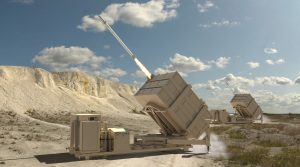Dynetics has detailed its proposal for the Army’s Indirect Fire Protection Capability (IFPC) program, offering the new Enduring Shield system based on its work with the previous Multi-Mission Launcher (MML) development effort.
Ronnie Chronister, Dynetics’ vice president for weapons technology and manufacturing, confirmed to reporters that the company submitted a bid ahead of the deadline last Friday and also participated in the Army’s recent IFPC live-fire “shoot-off” event. The “shoot-off” also featured at least one other competitor in a team of Israel’s Rafael and Raytheon Technologies [RTX] offering a version of the Iron Dome system. Dynetics is a business unit of Leidos [LDOS].

IFPC is the Army’s aim to field a new ground-based mobile system capable of defeating cruise missile and drone threats, with plans to award a prototype contract as soon as late August to deliver 16 launchers and 80 interceptors.
“It’s obviously a pretty fast, tight schedule requiring someone that has experience in performing this type of work in a quick manner,” Chronister said. “We have the experience and the agility to meet these kinds of quick program needs.”
Enduring Shield is based on the design of the company’s previously-canceled MML internal development effort, with a focus on building in improved production and cost efficiencies to the baseline design.
“Our offering is not MML but it was derived from the heritage and the things that we’ve learned from MML. As an example, we’ve gone through and redesigned that system to attain cost efficiencies, make it more producible, making it less complex. Those are the things that you’re going to need when you get into a program where you’re going to have to build 16 launchers in a relatively short period of time,” Chronister said.
Chronister would not disclose the interceptor that Dynetics has selected, citing the interceptor manufacturer’s request not to be named, while noting that Enduring Shield’s modular open systems architecture (MOSA) design enables it to be “missile-agnostic.”
“While we have selected this initial effector or interceptor, I mentioned that we designed our offering with the MOSA standards involved, so we are basically missile-agnostic. So if the customer comes back and wants to integrate another effector into our system, we have designed it as such that the integration will be seamless and relatively easy to accomplish.”
Enduring Shield is also capable of engaging targets with a “360-degreee envelope,” Chronister said, and added that the system also meets the Army’s key requirement to be able to integrate with the future Integrated Battle Command System.
During the roundtable with reporters, Chronister was asked about previous reload issues with the earlier MML launcher and said any potential problems have been resolved in the design of Enduring Shield.
“That data is dated. It goes back to the predecessor system and our offering has completely resolved both of those issues. We are very comfortable with the solutions that we have implemented and we believe that we’re on a good track there,” Chronister said.
The Army has previously procured two Iron Dome batteries as an interim IFPC solution, per a directive in the FY ‘19 National Defense Authorization Act.